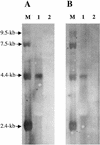In Lactobacillus plantarum, carbamoyl phosphate is synthesized by two carbamoyl-phosphate synthetases (CPS): carbon dioxide differentiates the arginine-repressed from the pyrimidine-regulated CPS
- PMID: 10852872
- PMCID: PMC101912
- DOI: 10.1128/JB.182.12.3416-3422.2000
In Lactobacillus plantarum, carbamoyl phosphate is synthesized by two carbamoyl-phosphate synthetases (CPS): carbon dioxide differentiates the arginine-repressed from the pyrimidine-regulated CPS
Abstract
Carbamoyl phosphate (CP) is an intermediate in pyrimidine and arginine biosynthesis. Carbamoyl-phosphate synthetase (CPS) contains a small amidotransferase subunit (GLN) that hydrolyzes glutamine and transfers ammonia to the large synthetase subunit (SYN), where CP biosynthesis occurs in the presence of ATP and CO(2). Lactobacillus plantarum, a lactic acid bacterium, harbors a pyrimidine-inhibited CPS (CPS-P; Elagöz et al., Gene 182:37-43, 1996) and an arginine-repressed CPS (CPS-A). Sequencing has shown that CPS-A is encoded by carA (GLN) and carB (SYN). Transcriptional studies have demonstrated that carB is transcribed both monocistronically and in the carAB arginine-repressed operon. CP biosynthesis in L. plantarum was studied with three mutants (DeltaCPS-P, DeltaCPS-A, and double deletion). In the absence of both CPSs, auxotrophy for pyrimidines and arginine was observed. CPS-P produced enough CP for both pathways. In CO(2)-enriched air but not in ordinary air, CPS-A provided CP only for arginine biosynthesis. Therefore, the uracil sensitivity observed in prototrophic wild-type L. plantarum without CO(2) enrichment may be due to the low affinity of CPS-A for its substrate CO(2) or to regulation of the CP pool by the cellular CO(2)/bicarbonate level.
Figures





Similar articles
-
Repression of the pyr operon in Lactobacillus plantarum prevents its ability to grow at low carbon dioxide levels.J Bacteriol. 2005 Mar;187(6):2093-104. doi: 10.1128/JB.187.6.2093-2104.2005. J Bacteriol. 2005. PMID: 15743958 Free PMC article.
-
Low carbamoyl phosphate pools may drive Lactobacillus plantarum CO2-dependent growth phenotype.J Mol Microbiol Biotechnol. 2008;14(1-3):22-30. doi: 10.1159/000107966. J Mol Microbiol Biotechnol. 2008. PMID: 17957107 Review.
-
The carbamate kinase-like carbamoyl phosphate synthetase of the hyperthermophilic archaeon Pyrococcus furiosus, a missing link in the evolution of carbamoyl phosphate biosynthesis.Proc Natl Acad Sci U S A. 1997 Nov 25;94(24):12803-8. doi: 10.1073/pnas.94.24.12803. Proc Natl Acad Sci U S A. 1997. PMID: 9371756 Free PMC article.
-
Extent of genetic lesions of the arginine and pyrimidine biosynthetic pathways in Lactobacillus plantarum, L. paraplantarum, L. pentosus, and L. casei: prevalence of CO(2)-dependent auxotrophs and characterization of deficient arg genes in L. plantarum.Appl Environ Microbiol. 2003 May;69(5):2674-83. doi: 10.1128/AEM.69.5.2674-2683.2003. Appl Environ Microbiol. 2003. PMID: 12732536 Free PMC article.
-
Carbamyl phosphate synthetase III, an evolutionary intermediate in the transition between glutamine-dependent and ammonia-dependent carbamyl phosphate synthetases.J Mol Biol. 1994 Oct 14;243(1):131-40. doi: 10.1006/jmbi.1994.1638. J Mol Biol. 1994. PMID: 7932737 Review.
Cited by
-
Oxygen relieves the CO2 and acetate dependency of Lactobacillus johnsonii NCC 533.PLoS One. 2013;8(2):e57235. doi: 10.1371/journal.pone.0057235. Epub 2013 Feb 26. PLoS One. 2013. PMID: 23468944 Free PMC article.
-
Analysis and Reconstitution of the Menaquinone Biosynthesis Pathway in Lactiplantibacillus plantarum and Lentilactibacillus buchneri.Microorganisms. 2021 Jul 9;9(7):1476. doi: 10.3390/microorganisms9071476. Microorganisms. 2021. PMID: 34361912 Free PMC article.
-
Deciphering the crucial roles of transcriptional regulator GadR on gamma-aminobutyric acid production and acid resistance in Lactobacillus brevis.Microb Cell Fact. 2019 Jun 13;18(1):108. doi: 10.1186/s12934-019-1157-2. Microb Cell Fact. 2019. PMID: 31196094 Free PMC article.
-
Repression of the pyr operon in Lactobacillus plantarum prevents its ability to grow at low carbon dioxide levels.J Bacteriol. 2005 Mar;187(6):2093-104. doi: 10.1128/JB.187.6.2093-2104.2005. J Bacteriol. 2005. PMID: 15743958 Free PMC article.
-
ISLpl1 is a functional IS30-related insertion element in Lactobacillus plantarum that is also found in other lactic acid bacteria.Appl Environ Microbiol. 2003 Oct;69(10):6032-40. doi: 10.1128/AEM.69.10.6032-6040.2003. Appl Environ Microbiol. 2003. PMID: 14532059 Free PMC article.
References
-
- Bringel F. Carbamoylphosphate and natural auxotrophies in lactic acid bacteria. Lait. 1998;78:31–37.
-
- Delannay S, Charlier D, Tricot C, Villeret V, Piérard A, Stalon V. Serine 948 and threonine 1042 are crucial residues for allosteric regulation of Escherichia coli carbamoylphosphate synthetase and illustrate coupling effects of activation and inhibition pathways. J Mol Biol. 1999;286:1217–1228. - PubMed
MeSH terms
Substances
Associated data
- Actions
LinkOut - more resources
Full Text Sources
Molecular Biology Databases
Miscellaneous

